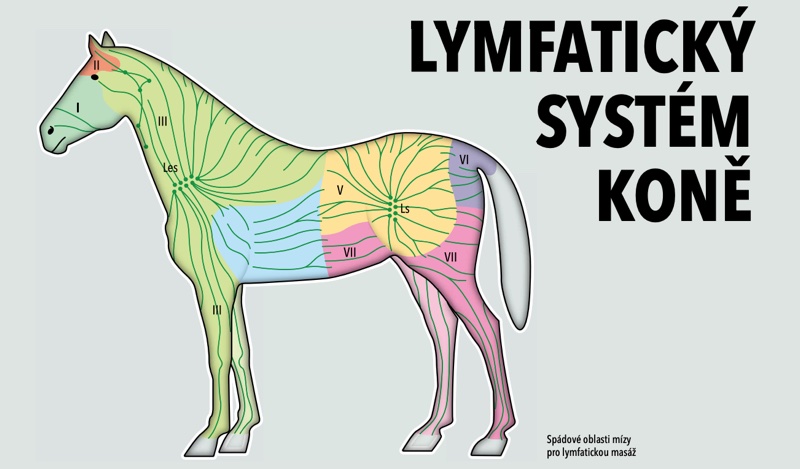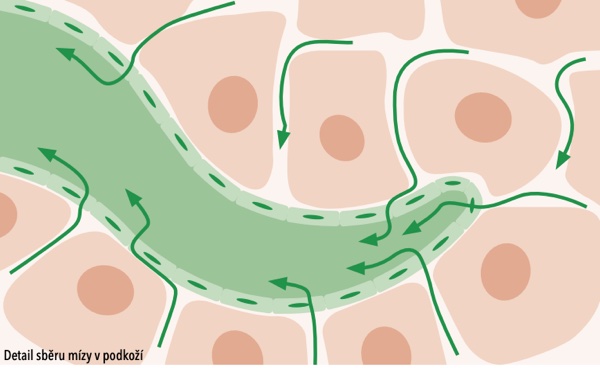Text Mag. med. vet. Ines Králová,
veterinarian doctor
Today we will try to bring you closer and explain the basic terms from this very young and quite often neglected area of medicine and how and why swelling of the limbs can occur in your horse, which sometimes troubles every breeder or rider.
History
Even before Christ, scholars of the time discovered large lymphatic veins. Hippocrates talked about veins that carry white blood, Aristotle talked about structures that contain colorless water, Herophilos wrote about veins that come from the intestine, but do not go through the liver. Unfortunately, this knowledge fell into oblivion for the next 2000 years. From 1622, mentions of various lymphatic formations and veins appear again in medicine. It was only in the 20th century that a new area of expertise in medicine appeared - lymphology. And that is what we will try to zoom in today and explain how it works when windgalls appear, or even swellings as big as an elephant's foot.


Lymph or sap
Lymph is a colorless watery fluid that percolate from the bloodstream into the subcutaneous tissue. Its composition is very similar to blood, but it does not contain red blood cells. The sap does not move around the body in a closed circulation like blood, but starts blindly in the subcutaneous tissue.
In a resting state, only a small amount of lymph is formed in the horse's body, approximately five to ten liters per day. With increased exertion, for example during sports, up to twenty-five liters of lymph is produced.
Lymphatic system
The lymphatic system includes all the lymphatic channels and lymph nodes that a horse has in its body. This also includes lymphatic organs such as the spleen and thymus. Compared to humans, who have only 600 lymph nodes in their body, horses have up to 8,000.
The lymphatic system has many important and indispensable functions, without which the immune system and the whole body of the horse would not be able to function.
The main function of the entire system is the so-called drainage, or removal of excess fluid from the subcutaneous tissue back into the bloodstream. As I already mentioned, this is a one-way "pipeline" system, where the created sap is pulled from the body back into the bloodstream. So we have to imagine a hypodermis consisting of cells, criss-crossed by a large number of small blood vessels, from which sap percolate under pressure. Lymphatic veins are also interwoven between the cells like the tentacles of a squid, they suck up the soaked liquid and carry it away so that it does not accumulate here. Gradually, on their way to the heart, these smallest lymphatic veins enlarge into the highly visible lymphatic veins and large lymphatic ducts and flow back into the bloodstream at the point where the internal and external jugular veins meet. (see image on the right)
Another function of the lymphatic circulation is the indispensable immunological and defensive support of the whole body. During the formation of lymph fluid, microorganisms such as bacteria, viruses and fungi percolate into the subcutaneous tissue, which together with the fluid travel through the lymph "pipeline" system to the lymph nodes, where the lymph is purified. Lymph nodes can be felt in some places under the skin in every individual. If such a node is working and ridding the body of harmful substances, it can increase its size several times, and from a small lymph node, which is the shape and size of a small bean, it can grow to the size of a walnut or larger.
An integral function of the lymphatic system is to maintain a constant amount of fluid in all systems in the body and to maintain a constant volume of fluid in the intercellular space.

The lymphatic circulation function
Sap, unlike blood, is not pumped through the body by the heart. Lymphatic veins have their own hearts embedded in the walls of the lymphatic veins. These hearts work like pumps with regular, tireless movements. It is a passive movement of fluid towards the heart. The upward movement of the liquid is actively assisted by the large muscles on the horse's legs. However, the muscles are only found in the upper part of the horse's limbs. In the lower part of the legs there are only tendons that cannot help with pumping.
Therefore, the lymphatic system has a very clever function of its own to fight the accumulation of fluid in the horse's legs, which is called the "safety valve function". If there is an accumulation of fluid in the subcutaneous tissue, for example if the horse stands in a box and does not have the opportunity to actively move in the paddock or under the saddle, the system is unblocked and can absorb more sap/fluid. If the "safety valve function" did not exist, excess fluid would remain in the intercellular space and the limbs would be constantly swollen. If the system is disturbed by, for example, a surgical wound or an injury, the very fragile system of lymphatic veins is disturbed and they lose all the functions described above, and the fluid cannot be drained away from the damaged areas. If this condition is not addressed, it can lead to edema or even elephant's leg.
A variable pressure inside the tentacles is needed in order for the liquid to enter the already mentioned tentacles between the cells. With each contraction of the muscle, there is a decrease and an increase in pressure. We can imagine it like squeezing and releasing a sponge under water. When we release the compressed sponge, it fills up again. Each such filling of the tentacles pushes the liquid upwards.
If, for some reason, the fluid filling and push system fails and the limbs begin to swell, we can help the horse by supporting the lymphatic circulation with lymphatic massage or by bandaging the limbs, either using normal insulating bandages or specially adapted bandages, the possibilities and use of which will be explained to you in the next article.
Editor's note: The original professional article was simplified during editing for the needs of the public.


